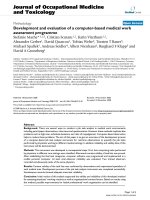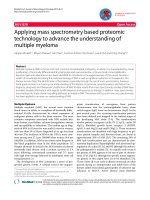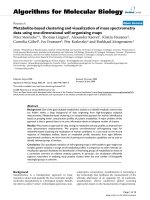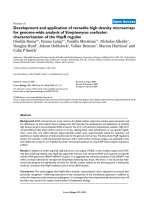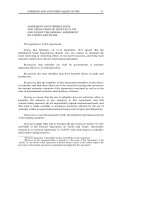Development and application of mass spectrometry based proteomics technologies to decipher ku70 functions
Bạn đang xem bản rút gọn của tài liệu. Xem và tải ngay bản đầy đủ của tài liệu tại đây (1.83 MB, 168 trang )
DEVELOPMENT AND APPLICATION OF
MASS SPECTROMETRY BASED PROTEOMICS
TECHNOLOGIES TO DECIPHER KU70 FUNCTIONS
MENG WEI
(B.S, NAN KAI UNIVERSITY)
A THESIS SUBMITTED
FOR THE DEGREE OF MASTER OF SCIENCE
DEPARTMENT OF BIOLOGICAL SCIENCES
NATIONAL UNIVERSITY OF SINGAPORE
2007
ACKNOWLEDGEMENTS
My deepest gratitude goes to my supervisor, Assistant Professor Sze Siu Kwan
for his patience, encouragements and professional guidance during the last two
years. My project will not be completed well without his help and
understanding.
My heartfelt thanks also go to my co-supervisors Dr. Ni Binhui and Dr. Walter
Stunkel. I was able to finish part of my project in S*Bio Pte Ltd because of
their help and valuable suggestions.
In addition, I would like to thank the persons who helped me a lot when I was
in Genome Institute of Singapore: Dr.Liu jining, who always discussed with
me for my project and gave me a lot of advice; Dr. Hua lin and Dr. Low Teck
Yew, who helped me to run mass spectrometry analysis.
I also want to thank Institute for Systems Biology and Dr. J. Donald Capra
who provided me the plasmids.
Special thanks should go to Associate Professor Chung Ching Ming and
Assistant Professor Dr. Mok Yu-Keung for their invaluable suggestions about
my project during the pre-submission seminar.
Especially, I would like my parents know that without their love, support and
understanding, this would not have been possible. I really appreciated their
trust.
Lastly, I thank National University of Singapore for awarding me a research
scholarship and thank Genome Institute of Singapore and S*Bio Pte Ltd
providing enough funding for my research.
i
Table of Contents
ACKNOWLEDGEMENTS .............................................................................i
Table of Contents .............................................................................................ii
Summary.........................................................................................................vii
List of Tables ...................................................................................................ix
List of Figures...................................................................................................x
List of Abbreviations ......................................................................................xi
Chapter 1 Introduction...................................................................................1
Chapter 2 Empore Disk Extraction of Peptides From In Solution and In
Gel Digestion.....................................................................................................9
2.1 Introduction........................................................................................10
2.2 Materials and Methods.......................................................................13
2.2.1 In Solution Empore Disk Extraction.......................................13
2.2.2 SDS-polyacrylamide Gel Electrophoresis (SDS-PAGE)........14
2.2.3 Silver Staining.........................................................................14
2.2.4 Simply Blue Staining ..............................................................14
2.2.5 In-gel Empore Disk Extraction ...............................................15
2.2.6 MALDI TOF/TOF MS/MS Analyses.....................................15
2.2.7 Data Analysis ..........................................................................16
2.3 Results................................................................................................16
2.3.1 In Solution Empore Disk Extraction.......................................16
2.3.2 In Gel Empore Disk Extraction...............................................17
ii
2.4 Discussion ..........................................................................................18
2.5 Conclusion .........................................................................................22
Chapter 3 Proteomics Studies on Ku70 Protein Complex by Tandem
Affinity Purification (TAP) Tag Pull Down and Mass Spectrometry.......23
3.1 Introduction........................................................................................24
3.1.1 Mass Spectrometry (MS) ........................................................24
3.1.2 Tandem Affinity Purification Strategy ...................................29
3.1.3 Ku70........................................................................................34
3.2 Materials and Methods.......................................................................38
3.2.1 Plasmid Constructions ............................................................38
3.2.2 Preparation of Ku70 Mutants..................................................39
3.2.3 Cell Culture.............................................................................39
3.2.4 Transient and Stable Protein Expression ................................40
3.2.5 Cell lysis and Quantitative Protein Essay for Cell Lysate ......40
3.2.6 SDS-polyacrylamide Gel Eletrophoresis (SDS-PAGE) .........41
3.2.7 Immunoprecipitation and Western Blot..................................42
3.2.8 Purification of Flag-tagged Ku70 ...........................................43
3.2.9 TAP Tag Purification..............................................................43
3.2.10 Crosslinking ..........................................................................44
3.2.11 Silver Staining.......................................................................45
3.2.12 Cell Cycle Analysis...............................................................45
3.2.13 Propidium Iodide Staining of Cells for FACS Analysis.......45
3.2.14 MTS Assay............................................................................46
iii
3.2.15 Sample Preparation for Mass Spectrometry .........................46
3.2.15.1 In Gel Digestion.................................................................46
3.2.15.1.1 Gel Bands........................................................................46
3.2.15.1.2 Gel Section......................................................................47
3.2.15.2 Solution Phase Digestion ...................................................47
3.2.15.3 Empore Disk Extraction.....................................................48
3.2.16 Mass Spectrometry Analysis.................................................48
3.2.17 Data Analysis ........................................................................49
3.3 Results................................................................................................49
3.3.1 Generation of Stable Mammalian Cell Lines Expressing GFPtagged, FLAG-tagged and TAP-tagged Ku70 .................................49
3.3.2 Purification of The Ku70 Complex.........................................53
3.3.3 In Vitro Closslinking of Ku70 Complex.................................55
3.3.4 Enrich of Cytoplasmic Pool of Ku70......................................60
3.3.5 Reduction of Protein Complexity in Eluate Submitting to Mass
Spectrometry ....................................................................................62
3.3.6 Identification of Ku70 Complex by Mass Spectrometry ........64
3.3.7 Validation of Search Result of Mass Spectrometry................67
3.3.8 Poly [ADP-ribose] Polymerase (PARP) May Interact With
Ku70 Through Ku80 ........................................................................72
3.3.9 Role of Ku70 in Apoptosis .....................................................72
3.4 Discussion ..........................................................................................73
3.4.1 Affinity Purification................................................................73
iv
3.4.2 Core Ku70 Complex And Other Regulated Ku70 Complex ..76
3.4.3 Analysis of Other Regulated Complex ...................................81
3.5 Conclusion .........................................................................................86
Chapter 4 In Vitro Acetylation Analysis of Ku70 ....................................109
4.1 Introduction......................................................................................110
4.2 Materials and Methods.....................................................................114
4.2.1 Plasmid Constructions ..........................................................114
4.2.2 Protein Expression ................................................................114
4.2.3 Time Course Analysis of Protein Expression .......................114
4.2.4 Determination of Target Protein Solubility ..........................115
4.2.5 Protein Purification ...............................................................115
4.2.6 In Vitro Acetylation ..............................................................116
4.2.6.1 PCAF Induced In Vitro Acetylation ..................................116
4.2.6.2 P300 Induced In Vitro Acetylation ....................................116
4.2.7 SDS-polyacrylamide Gel Electrophoresis (SDS-PAGE) and
Western Blot ..................................................................................117
4.2.8 Simply Blue Staining ............................................................117
4.2.9 Treatment of 293F Cells by HDAC Inhibitors ....................117
4.2.10 Sample Preparation for Mass Spectrometry .......................117
4.2.11 Mass Spectrometry Analysis...............................................118
4.2.12 Data Analysis ......................................................................119
4.3 Results..............................................................................................119
4.3.1 Optimization of Protein Expression......................................119
v
4.3.2 Purification of His-tagged Ku70...........................................121
4.3.3 In Vitro Acetylation of Ku70 ................................................121
4.3.4 In Vivo Acetylation of Ku70 .................................................123
4.3.5 In Vivo Acetylation of Ku80 .................................................123
4.4 Discussion ........................................................................................125
4.5 Conclusion .......................................................................................126
Chapter 5 Conclusion .................................................................................127
Reference .......................................................................................................130
vi
Summary
Ku70 is a protein with multiple biological functions. It is well-known
that Ku70 forms heterodimer with Ku80 and is essential for the repair of
nonhomologous DNA double-strand breaks. Recent studies showed that the
acetylation of Ku70 is a master switch in the apoptotic pathway. Therefore,
Ku70 might be a therapeutic target for cancer treatment, and it is important to
thoroughly study the Ku70 protein complex to unravel its biological functions.
We employed mass spectrometry based proteomic methods to characterize the
Ku70 protein complex. As proteomics is still in its infancy stage, we have
developed novel effective peptide purification and concentration method for
in-gel digestion sample in order to drill down to the details of the Ku70
complex by identification of both strong and weak binding partners.
In
addition, we have adapted one step FLAG-tag purification and two steps
tandem affinity purification (TAP) methods to purify the Ku70 protein
complex. The FLAG-tag and TAP-tag were fused in-frame to Ku70 gene and
the tagged-Ku70 fusion proteins expressed in 293F cell were used as bait to
pull down its interacting partners. The pulled-down complex was analyzed by
both SDS-PAGE coupled to MALDI-TOF/TOF-MS and shotgun LC-MS/MS
proteomics approaches. Epitope-tag based purification strategies enable
protein complex to be isolated with exceptional purity and eliminated
background of non-specific binding proteins. As a result, it has significantly
improved the outcome of mass spectrometry-based protein complex
vii
characterization and enables identification of weak interaction partners.
Consequently, 151 proteins were characterized in Ku70 protein complexes.
These proteins play a diverse range of biological functions from DNA repair
to transcriptional regulation to cellular signal mediator. Among these, 20 are
known Ku70 interacting proteins, they function mainly in DNA repairs and
telomeric maintenance. Others are mainly cytosolic proteins that are classified
to be apoptotic regulatory proteins or signal transduction proteins by Panther
gene ontology database. These are consistent with the recent reported Ku70
functions in regulating cellular apoptosis. As Ku70 acetylation has been
reported to be a pivotal post translational modification that regulates Ku70
activities, we finally identified the potential acetylation sites of Ku70 by both
in vivo and in vitro acetylation analysis. We are working to further
characterize the Ku70 complex by biochemical assays to understand its role in
cancer development and other human diseases.
viii
List of Tables
Table 2.1
Table 3.2
MS analysis of in solution and in gel digestion
Histones, ribosomal proteins, nuclear ribonucleoproteins, heat
shock proteins and tubulins in Ku70 complex
Other 94 proteins in Ku70 complex
88
Table 3.3
Molecular functions modulated by all complex proteins
92
Table 3.4
Biological processes modulated by all complex proteins
92
Table 3.5
Pathways modulated by all complex proteins
Listing of all complex proteins in each of the 19 biological
processes
Listing of all complex proteins in each of the 14 pathways
Complex proteins involving in mRNA transcription, DNA
repair and DNA replication
Comparision of acetylation sites of Ku70 under in vitro, in vivo
acetylation and reported acetylation sites
93
Table 3.1
Table 3.6
Table 3.7
Table 3.8
Table 4.1
19
87
ix
93
102
107
124
List of Figures
Figure 2.1
Silver staining of different amount of BSA
19
Figure 3.1
Generation of mammalian stable cell lines
51-52
Figure 3.2
54
Figure 3.5
Traditional IP pull down
purification of TAP-tagged and FLAG-tagged Ku70 and its
associated proteins
Crosslinking of Ku70 complex combined with TAP tag
purification.
Location of Ku70 during cell cycle
61
Figure 3.6
Cytoplasmic and nuclear pool of Ku70
63
Figure 3.7
Location of Ku70 and its mutants
63
Figure 3.8
Elution of proteins by NaCl gradient elution buffer
65
Figure 3.9
Molecular functions modulated by all complex proteins
68
Figure 3.10
Biological processes modulated by all complex proteins
69
Figure 3.11
Pathways modulated by all complex proteins
70
Figure 3.12
71
Figure 4.1
Validation of Ku70 associated proteins
HDACI induces cell death in 293F cells and Ku70
overexpressed 293F cells.
Protein-Protein interactions between Ku70 and its associated
proteins
Time course analysis of protein expression
120
Figure 4.2
Acetylation of Ku70 and Ku80
122
Figure 3.3
Figure 3.4
Figure 3.13
Figure 3.14
56-57
59
74
80
x
List of Abbreviations
two-dimensional gel electrophoresis
ammonium bicarbonate
acetyl-coenzyme A
acetonitrile
bovine serum albumin
octadecyl
octyl
collisionally activated or aided dissociation
chitin-binding domain
calmodulin-binding peptide
α-cyano-4-hydroxycinnamic acid
collision-induced dissociation
dimethyl pimelimidate
dimethylsulfoxide
DNA-dependent serine/threonine protein kinase
double-strand breaks
dithiothreitol
1-ethyl-3-(3-dimethylaminopropyl) carbodiimide
electrospray ionization
histone acetyltransferase
histone deacetylase
histone deacetylase inhibitors
high-performance liquid chromatography
iodoacetamide
immunoblotting
immunoprecipitation
Luria Bertani
matrix-assisted laser desorption/ionization
mass spectrometry
tandem mass spectrometry
nonhomologous end joining
polyacrylamide gel electrophoresis
poly(ADP-ribose) polymerase
phosphate-buffered saline
p300-CBP-associated factor
peptide mass fingerprinting
2D-PAGE
ABB
AcCoA
ACN
BSA
C18
C8
CAD
CBD
CBP
CHCA
CID
DMP
DMSO
DNA-PK
DSB
DTT
EDC
ESI
HAT
HDAC
HDACI
HPLC
IAA
IB
IP
LB
MALDI
MS
MS/MS
NHEJ
PAGE
PARP
PBS
PCAF
PMF
xi
phenlmethylsulfonyl fluoride
post-source decay
polytetrafluoroethylene
post-translational modification
suberoylanilide hydroxamic acid
strong-cation-exchange
sodium dodecyl sulfate
solid phase extraction
staurosporine
tandem affinity purification
tobacco etch virus
trifluoroacetate
time-of-flight
trichostatin A
PMSF
PSD
PTEE
PTM
SAHA
SCX
SDS
SPE
STS
TAP
TEV
TFA
TOF
TSA
xii
Chapter 1
Introduction
1
The completion of the genome sequences of the human and many
other organisms is undoubtedly a big step towards the full understanding of
biological sciences. The availability of enormous amount of data in the
genome and the expressed sequence tag (EST) databases opens new avenues
to analyze protein functions and leads us to the post-genomic era. Proteomics,
the global analysis of proteins, is a new field of research in the post-genomics
era. As proteins are the functional molecules that control the living process,
from structural elements, to catalysts, to signaling messengers and gene
regulatory transcription factors, proteomics data will provide rich information
to unravel how living systems work at the molecular level.
Proteins do not act alone. They usually form protein complexes to
exert different functions and transmit different signals. All the biological
activities depend upon direct physical interaction of specific cellular proteins.
Each protein in living matter functions as part of an extended web of
interacting molecules. The classic view of protein function focuses on the
action of a single protein molecule. However, to truly understand a
multifunctional protein, the isolated study of individual protein is not enough
and thorough. The pull down of protein complex in a given cell or tissue at a
defined condition will then provide a detailed information about the
interaction partners of a specific protein in a certain state. The interaction
partners will reveal the functions of the target protein. With the availability of
various databases such as Gene Ontology (GO) or Panther which collect all
the known molecular functions of proteins and group them to pathways and
2
biological processes, the functions of target protein can be classified to
functional pathways and biological processes by interrogating the set of pull
down proteins with these databases.
In characterizing binding partners for a molecule of interest, the
quality of the purified protein complex plays a critical role in the ultimate
success of the experiment. Classical biochemical purification methods rely
heavily on the biophysical properties of a given protein, for example, a typical
immunoprecipitation (IP). However, most antibodies usually cross-react with
many irrelevant proteins, thus generate significant background. Although it
will not interfere with the traditional biochemical assays such as Western
blotting which only probes for the presence of one specific protein, it will
generate significant false positive results when the pull down sample is
analyzed by mass spectrometry method which unselectively identifies all
proteins in the sample. To circumference the problem of nonspecific binding
contaminants, affinity purification procedures utilizing epitoge-tag or two
consecutive epitope tags - tandem affinity purification (TAP) steps have been
developed and proven to be highly effective in the identification of protein
complexes. In this tandem affinity purification (TAP) method, two affinity
tags with orthogonal purification properties such as IgG-binding domain of
protein A of Staphylococcus aureus (ProtA) and calmodulin-binding peptide
(CBP) are inserted into a vector. The protein of interest is fused to the TAP tag
and expressed in the organism or cell line under investigation. The two TAP
tags are separated by spacer regions and a cleavage site for tobacco etch virus
3
(TEV) protease. The fusion protein and associated components are first
recovered from cell extracts by affinity selection on an IgG matrix and eluted
by incubation with TEV protease. The eluates which contained protein
complexes were further purified by incubation with calmodulin coated beads
in the presence of calcium. Highly purified protein complexes were eluted by
depleting of calcium ions with EGTA. The two steps purification with two
different affinity chromatographic methods minimizes the nonspecific binding
contaminants. The whole procedure is carried out under mild, nondenaturing
conditions that maximize the chance of isolating an intact and functional
protein complex.
Detecting trace amount of TAP tag purified protein complex is
challenging. Compared with DNA analysis, trace DNA in a sample can be
detected by amplifying the DNA using polymerase chain reaction (PCR). A
method for amplifying protein has not yet been developed. Mass spectrometry
is the method of choice for protein identification and analysis because of its
sensitivity and accuracy.
Recent development in ionization methods and
improvement on instrumentation have significantly enhanced its performance
in protein characterization. It has rapidly become a standard method for
protein analysis.
Molecular weight is a unique property of each molecule. Mass
spectrometry is an instrument designed to measure molecular weight
accurately, and thus to characterize the molecule through its molecular weight.
The application of mass spectrometry for biomolecules analysis is triggered by
4
the recent advent of electrospray ionization (ESI) and matrix-assisted laser
desorption ionization (MALDI) methods. These soft ionization methods can
bring the fragile biomolecule into the gas phase with charges. The molecular
weight of the intact protein can be measured accurately by different types of
mass analyzers such as time-of-flight (TOF), quadrupole, quadrupole ion trap,
Orbitrap and Fourier transform ion cyclotron resonance (FTICR, also known
as FTMS). Coupling different ionization methods to different mass analyzers
provides a versatile set of mass spectrometry methods with surprising
sensitivity and accuracy for protein and other biomolecular analysis.
The true power of mass spectrometry for protein characterization is
the utilization of tandem mass spectrometry (MS/MS) and proteolytic
digestion for protein sequence analysis and for the localization of posttranslational modifications. Trypsin is by far the most widely used protease in
proteomic analysis. Trypsin cleaves proteins at lysine and arginine residues,
unless either of these is followed by a proline residue in the C-terminal
direction. The spacing of lysine and arginine residues in many proteins is
distributed relatively evenly. The resulting tryptic peptides are of a length
well-suited to MS analysis.
The most common MS/MS methods currently for protein
fragmentation involve low energy fragmentation by collisionally-activated
dissociation (CAD) or post-source decay (PSD). The sequence information is
obtained from the generation of fragments by the cleavage of the protein
backbone. The post translational modification of protein can be determined by
5
the shift in mass of fragments with the molecular weight of the modified
functional group.
The detection of post-translational modification (PTM) is another
important application of modern mass spectrometry. PTM represents an
important mechanism for regulating protein function. Lysine acetylation, or
the transfer of an acetyl group from acetyl coenzyme A to the ε-amino group
of a lysine residue, is among the most important post-translational
modifications. It was initially discovered on histones. But later many
nonhistone proteins were also found to be acetylated indicating the critical role
of this modification. This project focuses on Ku70, a protein with multiple
functions and can be acetylated by histone acetyltransferase. The TAP
purification and mass spectrometry analysis of Ku70 complex will be
described and discussed in Chapter 3. The in vivo and in vitro acetylation of
Ku70 will be discussed in Chapter 4.
As proteomics is still in its infancy stage, technology development is
the key to advance the field to address more sophisticated biological questions.
Since the success of a mass spectrometry based proteomic analysis critically
depend on the samples quality, an optimal sample preparation is one of the
most important factors in proteomics analysis. Particularly, the interface
between protein digestion and mass spectrometric analysis has a large
influence on the overall quality and sensitivity of the analysis. As salt and
detergent are detrimental to ionization process, a typical sample preparation
involves in-gel digestion, sample extraction and concentration, desalting and
6
elution. Solid phase extraction (SPE) is a widely used technique for the
purification and concentration of analytes from liquid samples to improve
sensitivity
in
the
analytical
process.
Commercial
tips
containing
chromatographic material polymerized into pipette tips (ZipTips, Millipore)
have also been introduced and are widely used. However, both of them have
some shortcomings. New methods which have large binding capacity, small
elution volume, minimum sample lost are still under development. Here we
developed a novel method for concentration and purification of proteolysis
products by using small pieces of Empore Disk (3M, Minneapolis, MN). The
Empore Disk is a particle-loaded membrane that incorporates tightly solid
phase sorbent particles within an inert matrix of polytetrafluoroethylene. The
high density of the particles increases the extraction efficiency and reduces the
elution volumes. Chapter 2 will describe this newly developed method.
Overview
This dissertation describes development and application of mass
spectrometry based proteomics technologies to decipher Ku70 biological
functions. We first improve the proteomics sample preparation method in
order to enhance the sample recovery after tryptic in gel digestion. Chapter 2
describes this newly developed method for concentration and purification of
proteolysis products by using small pieces of Empore Disk (3M, Minneapolis,
MN). This method has been applied to maximally recovery peptides from ingel and in-solution digestion. Then we generated two cell lines with stable
7
transfected FLAG and TAP tagged Ku70 in HEK293F cell respectively.
Chapter 3 describes the tandem affinity purification and mass spectrometry
analysis of Ku70 complex. The in vivo and in vitro acetylation analysis of
Ku70 is discussed in Chapter 4.
8
Chapter 2
Empore Disk Extraction of Peptides
From In Solution and In Gel Digestion
9
2.1 Introduction
In the post-genomic era, proteomics research attracts much effort to
identify new biomarkers or targets for drug discovery. Protein identification
by mass spectrometry plays an important role in proteomics research because
of the sensitivity, specificity and speed of mass spectrometer. Since the
sensitivity and accuracy of the analysis critically depend on the quality of
sample to be analyzed by mass spectrometry, optimal sample preparation is
one of the most critical factors for positive result in proteomics analysis.
Particularly, the interface between protein digestion and mass spectrometric
analysis usually determines the overall quality and sensitivity of the analysis.
A proteome can be characterized by either shotgun proteomics
approach with LC-MS/MS or 2D gel approach couple to mass spectrometry
for gel spot identification. In shotgun approach, the protein mixture is first
digested in solution to a complex peptide mixture. The peptide mixture is then
separated by multi-dimensional liquid chromatography coupled to on-line
electrospray ionization (ESI). Peptide ions generated by ESI are subsequently
subjected to collision induced dissociation in tandem mass spectrometer to
sequence the peptides. In gel approach, the protein mixture is separated by
polyacrylamide gel electrophoresis. Proteins are detected by staining methods.
Relevant protein bands or spots are then cut out, digested with trypsin “in gel”,
and the resulting peptide mixtures are analyzed by MALDI-TOF-MS or LCMS/MS to identify the protein.
10
The peptide samples obtained by proteolysis are usually not directly
analyzed, because they are in buffer with high concentration of salts or
detergents that are not compatible with high-sensitivity mass spectrometric
analysis, or the concentration of the samples are too diluted to be directly
detected. Concentration and purification are routinely achieved by binding of
the peptides to reversed-phase material in microcolumns or microtips. The
peptides are then eluted off-line in one or several steps for subsequent analysis
by mass spectrometry.
Solid phase extraction (SPE) is a widely used technique for the
purification and concentration of analytes from liquid samples to achieve
increased sensitivity in the analytical process. Bonded silica sorbents are
commonly used for the solid phase extraction of analytes from complex
samples. A variety of functional groups, such as octadecyl (C18) and octyl (C8)
can be bonded to the silica surface to provide non polar interactions. Each of
these sorbents exhibits unique properties of retention and selectivity for a
particular analyte.
Commercial tips containing chromatographic material polymerized
into pipette tips (ZipTips, Millipore) have been introduced and are widely used
for concentration and purification of femtomoles to picomoles of biomolecules
for MS analysis. The ZipTips pipette tips are simple and easy to use for single
or few samples. However, the operation is tedious for large amount of samples.
The need to pass the same sample through the material multiple times
manually introduces repetitive pipetting steps. Besides their high material
11
costs, the binding properties of these tips and the required elution volumes
have been found unsatisfactory by some researchers (Larsen et al., 2002).
ZipTips are also not readily coupled to nanoelectrospray needles.
Here we developed a method for concentration and purification of
proteolysis products by using small piece of Empore Disk (3M, Minneapolis,
MN). The Empore Disk is a particle-loaded membrane. This membrane can be
secured into a variety of devices that offer advantages. The Empore membrane
technology incorporates tightly solid phase sorbent particles within an inert
matrix of polytetrafluoroethylene (90% sorbent: 10% PTFE, by weight). The
high density of the particles increases the extraction efficiency and reduces the
elution volumes. At the same time, the PTFE fibrils do not interfere with the
activity of the particles in any way.
Many C18 microspin columns were developed in recent years for the
desalting and concentration of peptides (Rappsilber et al., 2003; Naldrett et al.,
2005; Ishihama et al., 2006). These devices are expensive and low throughput.
We introduce here a simple, inexpensive and efficient method for peptide
extraction from digestion buffer by C18 Empore Disk. A small piece of C18
Empore material can be reproducibly corked out by a hollow tool, such as a
blunt tipped hypodermic needle or a 200 μl pipette tip in exactly the same way
that cookies are cut. One disk is sufficient for producing thousands of such
membrane disks. Peptides in aqueous solution bind to C18 materials through
hydrophobic interactions, allowing small interfering molecules (salts,
12



